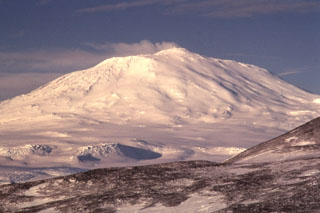Report on Erebus (Antarctica) — May 1978
Scientific Event Alert Network Bulletin, vol. 3, no. 5 (May 1978)
Managing Editor: David Squires.
Erebus (Antarctica) Lava lake persists; Strombolian eruptions from nearby vent
Please cite this report as:
Global Volcanism Program, 1978. Report on Erebus (Antarctica) (Squires, D., ed.). Scientific Event Alert Network Bulletin, 3:5. Smithsonian Institution. https://doi.org/10.5479/si.GVP.SEAN197805-390020
Erebus
Antarctica
77.53°S, 167.17°E; summit elev. 3794 m
All times are local (unless otherwise noted)
Geologists from France, New Zealand, and the U.S. conducted studies on Mt. Erebus between 2 and 17 January. The anorthoclase phonolite lava lake, which has persisted since its discovery in December 1972, occupied the entire N half of the inner crater. There were two zones of upwelling in the 130-m-long, oval-shaped lake: one at the extreme SW end (often obscured by fumes) and a second ~30 m from the E end. Doming of the lava lake surface was occasionally observed, including one large blister that grew to ~80 m height before bursting.
Between two and six moderate Strombolian eruptions occurred daily (54 during the 16-day observation period) from a vent ~30 m S of the lava lake. The eruptions lasted 1-15 seconds and were frequently followed by emission of fume clouds containing Pelé's hair up to 15 mm long and 3 mm in diameter. Bombs up to 0.3 m in diameter were thrown over the main crater rim (~270 m higher than the vent) and bombs as large as 10 m in diameter were found near the vent. The vent had built a small spatter cone with an orifice 2-3 m across containing a small lava pool (briefly absent after eruptions).
Oscillations of the lava lake level were observed three times on 16 January. The oscillations were periodic, with an amplitude of about 2 m and a period of between 14 and 18 minutes. There was no apparent correlation with explosive activity.
Geothermal activity had changed little from previous observations. However, large cracks were developing above geothermal features on the N wall of the main crater and may lead to collapse in this area. The cracks, 30-100 mm wide and 1.5 m deep in many places, were traced about 200 m around the N main crater rim. Material falling from this area would land in the lava lake.
Geological Summary. Mount Erebus, the world's southernmost historically active volcano, overlooks the McMurdo research station on Ross Island. It is the largest of three major volcanoes forming the crudely triangular Ross Island. The summit of the dominantly phonolitic volcano has been modified by one or two generations of caldera formation. A summit plateau at about 3,200 m elevation marks the rim of the youngest caldera, which formed during the late-Pleistocene and within which the modern cone was constructed. An elliptical 500 x 600 m wide, 110-m-deep crater truncates the summit and contains an active lava lake within a 250-m-wide, 100-m-deep inner crater; other lava lakes are sometimes present. The glacier-covered volcano was erupting when first sighted by Captain James Ross in 1841. Continuous lava-lake activity with minor explosions, punctuated by occasional larger Strombolian explosions that eject bombs onto the crater rim, has been documented since 1972, but has probably been occurring for much of the volcano's recent history.
Information Contacts: B. Scott, NZGS, Rotorua.

